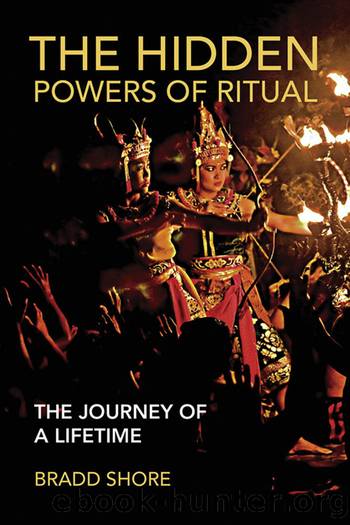The Hidden Powers of Ritual by Bradd Shore

Author:Bradd Shore [Shore, Bradd]
Language: eng
Format: epub
Publisher: MIT Press
Published: 2023-11-20T00:00:00+00:00
7
Nostalgic Commemoration: Salem Camp Meeting
Ritual is a kind of remembering. Among ritualâs numerous powers is the ability to shape social memory. Social memory is collective remembering by a group or a community, memories evoked by stories, photographs, histories, plays, novels, memorials, or celebrations. While we usually assume remembering is done by individuals, many of our recollections are formed through collective activity and are about things experienced with others. In rare cases, social memory is a recollection of something directly experienced. More commonly, however, it is simulated, a recollection of something that the group has not directly experienced. In most commemorations, what people actually recall are the repeated performances of commemoration rather than the event or person being commemorated. The original experience is an imagined memory.
In this chapter, we will witness some moments in the creation of a collective memory of family by listening to longtime campers who attend an annual camp meeting in central Georgia. Family memory is often inscribed in stories, anecdotes, photographs, or, increasingly, videos (Barclay and Koefoed 2021; Shore and Kauko 2018). Family memories are also evoked by things, whether simple objects or treasured family heirlooms. Another important source of family memory are collective rituals such as the annual camp meetings, religiously inspired revivals that occur throughout the United States every summer.
Commemorations come in various keys, triggering different emotions. Nostalgic recollections unfold in a major key, celebrating treasured memories that are sweetened by regular repetition. Powered by an impulse to idealize, nostalgic memory views history through ârose-colored glasses.â Sometimes nostalgia involves recalling actual events, memories positively framed, as when we recount fond memories of childhood or family outings. Nostalgic memories are summoned by photos, treasured objects, or, more diffusely, by smells and tastes that bring to mind earlier times. The current craze for cell phone photography has produced âprospective memoriesâ of family life, family photos and videos taken to provide anticipated future memories of family time.
In addition to nostalgia for our past experiences, there is also an imagined nostalgia for a place or a time that never existed. We have no words to distinguish nostalgia for places, people, and things in our past from the nostalgia we experience for an imagined experience. Imagined nostalgia rests on simulated memories, filling a wished-for place that is absent from our experience. We enter Disneylandâs Magic Kingdom by stepping onto Main Street, USA, a nostalgic simulation of an idealized American small town from bygone times. By reducing the scale of the buildings to three-fourths on the first floor, five-eighths on the second floor, and half scale on the third, Disneyâs âImagineersâ have produced an illusion intended to trigger a sense of control and comfort. The general reduction in scale creates a realistic playscape rather than a real town. The reduction of scale on upper stories makes the buildings appear higher than they are. An exception is the Town Square Exhibition Hall, which is recreated full scale to block the view of the Contemporary Resort. Walt Disney wanted no distractions from the illusion of a return to a simpler times.
Download
This site does not store any files on its server. We only index and link to content provided by other sites. Please contact the content providers to delete copyright contents if any and email us, we'll remove relevant links or contents immediately.
The Lost Art of Listening by Michael P. Nichols(7456)
Why I Am Not A Calvinist by Dr. Peter S. Ruckman(4125)
The Rosicrucians by Christopher McIntosh(3493)
Wicca: a guide for the solitary practitioner by Scott Cunningham(3149)
Signature in the Cell: DNA and the Evidence for Intelligent Design by Stephen C. Meyer(3103)
Real Sex by Lauren F. Winner(2989)
The Holy Spirit by Billy Graham(2917)
To Light a Sacred Flame by Silver RavenWolf(2792)
The End of Faith by Sam Harris(2709)
The Gnostic Gospels by Pagels Elaine(2499)
Waking Up by Sam Harris(2427)
Nine Parts of Desire by Geraldine Brooks(2345)
Jesus by Paul Johnson(2331)
Devil, The by Almond Philip C(2305)
The God delusion by Richard Dawkins(2284)
Heavens on Earth by Michael Shermer(2260)
Kundalini by Gopi Krishna(2151)
Chosen by God by R. C. Sproul(2143)
The Nature of Consciousness by Rupert Spira(2070)
